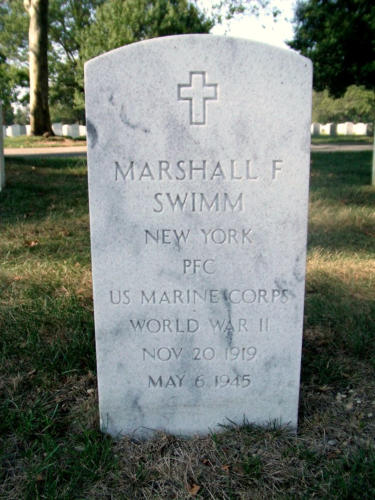
copyright © Wartime Heritage Association
Website hosting courtesy of Register.com - a web.com company
Wartime Heritage
ASSOCIATION

Remembering World War II
Marshall Franklyn Swimm

Name:
Marshall Franklyn Swimm
Rank:
Private 1st Class
Service Number:
972375
Service:
Company F, 2nd Battalion,
5th Marine Regiment,
1st Marine Division, Fleet Marine Force
United States Marine Corps
Date of Birth
November 20, 1919
Place of Birth:
Clark's Harbour, Shelburne Co., NS
Marital Status:
Single at Enlistment
Next of Kin:
Jean Ramsay Swimm (Wife)
Religion:
Protestant
Height:
5 feet, 10 ¾ inches
Complexion:
Light
Hair:
Black
Eyes:
Blue
Date of Death:
May 6, 1945
Age:
25
Cemetery:
Long Island National Cemetery,
New York, US
Grave:
Section J, Site 13762
Marshall Franklyn Swimm was the son of William Franklyn Swimm (1889-1960) and Gertrude I (Kenney)
Swimm (1893-1975). Both his parents were born in Clark’s Harbour, NS. He had a sister Winnifred Juanita
Swimm (1915-1998) and a brother Alton Earle Swimm (1918-1994).
Marshall married Jean Ramsay Hill (1913-1999) on February 23, 1940, in Martin,
Marion County, Florida. Jean was born in West Palm Beach, Florida.
When he completed his registration for the US Draft on July 1, 1941, in Suffolk
County, New York, he was living in Huntington, Suffolk, NY, and working as a sander
for J. T. Cautrell in Huntington.
After the outbreak of war, the 5th Marines, known as the "The Fighting Fifth", were
deployed to Wellington, New Zealand in June 1942. They fought on Guadalcanal, New
Britain, Eastern New Guinea, Peleliu and Okinawa.
PFC Swimm’s exact date of enlistment is unknown but he appears in the Marine Muster Rolls in July 1944
with the Seventh Recruit Battalion, Recruit Depot, at the Marine Barracks in Parris Island, South Carolina.
By October 1944, he is with the 20th Replacement Draft, Marine Battalion, Fleet Marine Force at Camp
Joseph H. Pendleton in Oceanside, California.
He shows in the Marine Muster Rolls with his unit, the 5th Marine Regiment, 1st Marine Division, in January,
and again in April 1945.
The Battle of Okinawa took place from April 1 to June 22, 1945. Private 1st Class Marshall Franklyn Swimm
was Killed in Action in the Battle of Okinawa on May 6, 1945.
Everything about the terrain on Okinawa favored the defending army. The topography of ridge lines
and escarpments turned the field of battle into a series of small, vicious firefights that allowed the
Japanese full observation of their enemy due to the lack of dense vegetation. Interlocking fields of
fire from the caves and concrete Okinawan tombs all over the ridge lines provided for intense and
heavy small arms fire, while Japanese artillery could be brought to bear on the attacking Marines in
seconds by numerous guns camouflaged into hill and ridge sides, unseen by American eyes.
The veteran warriors of the 5th Marine Regiment moved into the lines on May 1, 1945. On the first
night of action the 5th Regiment was assailed by Japanese infiltrators in a series of small assaults
that broke down into ferocious hand to hand combat each time. In the morning, the Marines had
beaten off the attackers. Dead Japanese lay strewn across the battlefield, some with Marine Ka-
Bars sticking in their chests, some disembowelled by Marine bayonets, and still others peppered
with shrapnel from Marine grenades or holed by rifle and machine gun rounds.
The survivors of the night assault received an unexpected break after the fight. During the early
morning hours of May 2, it started to rain. And rain. And rain. The rain poured down in buckets on
the 5th Marines, so much so that the unit had difficulty moving at all, and all offensive action
ceased. The break allowed the men to catch their breath and prepare for the upcoming assault that
began the following day. The Marines emerged from the mud (a scene that would play itself out
again and again for the remainder of the campaign) and pushed forward into heavy fire. Despite the
enemy fire, the Marines advanced forward with the help of the Army’s 27th Infantry Division field
artillery. Nearly a week later, the Marines had reduced the Awacha Pocket and suffered accordingly.
Casualties had been high but the 5th Regiment had prevailed and been able to eliminate the fierce
pocket of Japanese resistance, only to prepare to move onto the next ridge line ahead.
Private 1st Class Marshall Franklyn Swimm’s
body was returned to the United States and he
was interred in the Long Island National
Cemetery in Farmingdale, Suffolk County, New
York.

Sources:
The Invasion of Okinawa
Nationwide Gravesite Locator, National Cemetery Administration, US Department of Veterans Affairs


Jean Ramsay Hill



- World War I - Menu
- WWI Stories and Articles
- Photos - Yarmouth Soldiers
- Selection of World War I Songs
- WWI Casualties of Yarmouth, NS
- Those Who Served - Yarmouth, NS
- WWI Casualties Digby Co. NS
- WWI Casualties Shelburne Co. NS
- Merchant Mariners (1915) Yarmouth, NS
- Canadian Forestry Corps - Non Yarmouth Birth/Residence Enlistments
- US Draft Registry - Yarmouth NS Born


- World War II - Menu
- WWII Stories and Articles
- Telegraphist Air Gunners
- WWII Casualties of Nova Scotia
- US Casualties with NS Connection
- Far East/Pacific Casualties with NS Connection
- Merchant Navy Casualties Nova Scotia
- Nova Scotia WWII Casualties Holten Canadian War Cemetery
- D-Day Casualties - Nova Scotia
- CANLOAN Program Casualties - Nova Scotia
- Battle of the Bulge Casualties - Nova Scotia
- WWII Casualties Yarmouth NS
- Yarmouth Casualties - RCAF RAF Canadian Army WWII
- Yarmouth Co., Marriages WWII
- Casualties Non-Born/Residents with Connection to Yarmouth Co., Nova Scotia.
- WWII Casualties Digby Co., NS
- Non-Nova Scotian WWII Casualties Buried in Nova Scotia
- WWII RCAF Casualties Aged 16-18
- Brothers/Sisters Who Served - World War II













